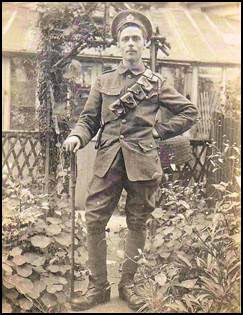
57751
Sapper
GEORGE RICHARDSON
Royal Engineers
By
Lieutenant Colonel (Retired)
Edward De Santis, MSCE, P.E., MinstRE
(March 2023)

Figure 1. A Photograph
Thought to be 57751 Sapper George Richardson, R.E.
(Postcard
photograph in the author’s collection)
INTRODUCTION
This is the story of the life and military service of a man who should never have been a soldier, much less a soldier in the Corps of Royal Engineers during the Great War of 1914-1918. His story has been derived primarily from his military service papers and family trees found on Ancestry.com. His family life was rather complicated, as his mother had been a widow with a number of children before she married his father. One of her children, George’s half-sister, became his next of kin when his wife died, probably in childbirth, and his half-sister raised his son.
George must have had a difficult life as a young man growing up in Belfast, so difficult in fact that joining the Army at the age of 35 to fight in a war must have seemed to be his only option. He was soon to learn that life in the Army was even more difficult than life in Belfast.
George Richardson’s military service papers are difficult to read in some places due to small and illegible handwriting, smudged pencil entries and smeared ink entries. The reader should be aware that certain information, especially dates, may be inaccurate due to this problem.
2. FAMILY INFORMATION AND EARLY LIFE
Family Information[1]
George Richardson’s mother, Agnes Stevenson (1839-1906) was born in Caskum, Aghaderg Parish, Ireland on 6 June 1839. Agnes married one William Dalzell (1829-1867) in Belfast on 1 March 1860. Agnes and William had a number of children before William’s death, who ultimately would become half-brothers and half-sisters of George Richardson. These siblings were:
Margaret Dalzell (1861-1931), born in Belfast on 6 June 1861.
Anna Dalzell (1862-1880), born in Belfast on 16 October 1862.
William Dalzell (1865-1917), born in Newtownards, Ireland.[2]
Agnes Stevenson Dalzell (1867-1942), born in Belfast on 27 April 1867.
William Dalzell, the elder, died in Belfast in 1867 and Agnes remained a widow until 1882 when she married William John Richardson (1853-1888) in St. Anne’s Church in Shankill, Dublin, Ireland on 28 November 1882. However, before his marriage to Agnes Dalzell, William John Richardson had fathered a son and a daughter; John Richardson (1875-1910) in Belfast, and Susannah Richardson (1877-1917) in Greencastle, Ireland. Existing family trees show the mother of these two children as “Unknown.” One wonders if John and Susannah could have been pre-marital births by Agnes prior to her marriage with William John Richardson in 1888.
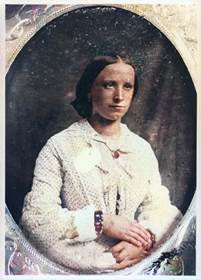
Figure 2. Agnes
Stevenson.
(Image courtesy of Robert Spears)
Early Life
George Richardson, the principal character of this story, was born in Shankill, County Antrim, Ireland in 1883, the son of William John Richardson and Agnes Richardson, née Stevenson (the widow Dalzell). In addition to George, William and Agnes had another son, Thomas Alexander Richardson (1886-1962) born in Belfast. Unfortunately, William John Richardson died in Belfast on 6 February 1888 at the age of 35, leaving Agnes once again a widow with two small sons to raise.
The Richardson Household in 1888
Address: 49 Stanley Street, Belfast, Ireland.[3] |
|||||
Name and Surname |
Relation |
Marital Status |
Age |
Profession or Occupation |
Birthplace |
William John Richardson |
Head |
Married |
35 |
Unknown |
Belfast, |
Agnes Richardson |
Wife |
Married |
49 |
|
Caskum, |
George Richardson |
Son |
|
5 |
|
Shankill, |
Thomas Alexander Richardson |
Son |
|
2 |
|
Belfast, |
Based on information that he provided to the Army, George Richardson was a Joiner in civil life before he enlisted. He married one Sarah Reid (?-1901) on 7 June 1901 and she gave birth to a son in Belfast that they named George (1901-1975). Sarah died in 1901, probably during childbirth, so their marriage could only have lasted a few months.
Agnes Richardson died in Belfast in 1906. Her last place of residence was 22 Symons Street in Belfast where presumably she and her two sons lived after the death of William John Richardson.
George Richardson’s brother John died in Belfast in 1910 at the age of 35 just as his father had. In 1911 George was living with his 9-year old son at 261 Springfield Road in Woodvale, County Antrim. His son George was a scholar and George, Sr, presumably was working as a Joiner.[4]

Figure 3. 22 Symons Street,
Belfast, Ireland, c. 2022.
(Image courtesy of Google Earth)
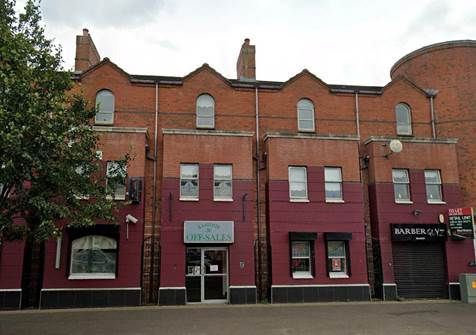
Figure 4. Buildings in the
Area of 261 Springfield Road, c. 2022.
(Image courtesy of
Google Earth)
Prior to enlisting in the Army George Richardson was residing at 20 Wauchope Street in Belfast.[5] At the time he may have given his son over to his half-sister Margaret Cooke, née Dalzell, to raise. She had married and was living at 24 Springfield Road in Belfast.
3. PHYSICAL DESCRIPTION
The following is a description of George Richardson when he enlisted in the Army in 1914.
Age: |
35 |
Height: |
5 feet 11½ inches |
Chest (expanded): |
38 inches |
Range of expansion: |
2½ inches |
Distinctive marks: |
Scar left groin |
Religious denomination: |
Church of England |
4. RECRUITMENT, ENLISTMENT AND TRAINING
Recruitment
When recruited for service Richardson claimed that he was a Joiner by trade, that he had no prior naval or military service and that he was a widower. He indicated that his next of kin was his sister, Margaret Cooke, of 24 Springfield Road in Belfast.
Enlistment
He attested for service in the Royal Engineers on 14 December 1914 and was certified on that date by the Approving Officer for service in a Royal Engineers field company. He was posted as 57751 Sapper George Richardson, R.E. on 19 December 1914, presumably to the School of Military Engineering at Chatham
Training
With the war increasing in scale and requiring ever more men at the front, his recruit training was surely abbreviated. After learning the fundamentals of field engineering he was transferred to the 150th Field Company on 18 August 1915, after eight months of training.
5. POSTINGS, ASSIGNMENTS AND CAMPAIGN SERVICE
Home Service (1914-1915)
The 150th Field Company was part of the 36th Division, which was undergoing mobilization and training in the U.K. The 36th (Ulster) Division was part of Lord Kitchener's New Army, formed in September 1914. Originally called the Ulster Division, it was made up of mainly members of the Ulster Volunteer Force, who formed thirteen additional battalions for three existing regiments: the Royal Irish Fusiliers, the Royal Irish Rifles and the Royal Inniskilling Fusiliers. However, regular Officers and Soldiers and men from all around the United Kingdom made up the strength of the Division.
By May of 1915 it appeared that George Richardson was not cut out for military service. From 11 May to 15 May 1915 he was absent without leave from his unit. On 16 May he was in detention awaiting trial and from 17 May to 30 May he was undergoing sentence imposed on him for his absence. He returned to his unit on 31 May.
On 1 June 1915 he was awarded 28 days detention for an offense that is not clearly stated in his military service record. From 28 June to 30 June 1915 Richardson was absent without leave and was sentenced to 72 hours of solitary confinement. From 2 August to 17 August 1915 he was again absent without leave and from 18 August to 26 August he was placed under guard detention pending trial. On 27 August he was sentenced to 42 days detention. On 11 September 1915 while undergoing detention, he was charged with striking a superior officer. For this offense he was sentenced to 274 days detention.
France and Flanders (1916-1917)
On 3 January 1916 Sapper Richardson was released from detention early so that he could deploy to France to join his unit. His Home Service up to this point was reckoned at 1 year and 16 days. He departed to join his unit on 4 January 1916. His company, the 150th Field Company, had been in France since 5 October 1915. It had not yet been engaged in any major actions by the time that Richarson joined it. However, we he arrived in France he did not join his company, but instead he was sent to a General Base Depot, probably No. 4 General Base Depot for the Royal Engineers at Rouen and was immediately posted to the 122nd Field Company. Based on his photograph at the beginning of this narrative, it appears the Sapper Richardson was assigned to the mounted section of the company. The bandolier of cartridge pouches and his spurs are indicative of a mounted Sapper.
The 122nd Field Company also formed part of the 36th Division in the X Corps of the British Fourth Army. Richardson and his company took part in the horrendous Battle of the Somme which began on 1 July 1916. On 4 July the X Corps was removed from the line and transferred to the Reserve Army.
In October of 1916 Richardson was placed under close arrest for desertion. On 14 October he was sentenced by Field General Court Martial to 20 years, but his sentence was commuted to 5 years with the remaining 15 years being suspended. As many soldiers were executed after being convicted of desertion, Richardson was fortunate in that his sentence was confinement. The suspension of 15 years of the 20-year sentence also is indicative of the nature of his absence from duty. Perhaps he was able to present mitigating circumstances to indicate that he was not absent to avoid a battle or that he had no intention to remain absent permanently. His company was not in the front line at the time, so this probably was not difficult for him to do.
After a quiet period out of the front line, the 122nd Field Company was next involved in the Battle of Messines from 7 to 14 June 1917. During the period from 8 to 24 June Richardson was placed under close arrest. He was tried by Field General Court Martial on 25 June and was found guilty of drunkenness while undergoing field punishment. On 18 July 1917 he was admitted to No. 5 Prison for detention. On 29 July 1917 his previous sentence of 5 years imprisonment was commuted to a sentence of 2 years at hard labour.
Home Service (1917)
It appears the Richardson became seriously ill at the end of August or the beginning of September 1917. On 2 September 1917 he was admitted to the 30th General Hospital at Calais. After spending over a month in the hospital, on 9 October 1917 Richardson was returned to the U.K., having served just 1 year and 280 days with the British Expeditionary Force in France. On 10 October 1917 he was posted to the Royal Engineers Training Center at Newark, Nottinghamshire. The unexpired portion of his prison sentence was remitted, probably due to the serious nature of his illness.
On 16 October 1917 Sapper Richardson was admitted to the Barrack Section of Queen Alexandra Military Hospital in Millbank, London, Ward D, Bed 8. He was diagnosed with tubercle of the lung. Tubercles are nodules that contain caseous necrosis, which form in the lungs as a result of an infection with Mycobacterium tuberculosis in patients with tuberculosis. Tubercles are also known as tuberculous nodules, or tuberculomas. This was obviously a very serious illness, as Richardson succumbed to it on 17 November 1917. He was buried at Brookwood Military Cemetery in Surrey, Grave XIII.E.1A with the inscription on his gravestone: PEACE PERFECT PEACE.
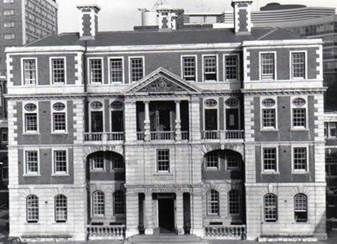
Figure 5. Queen Alexandra
Military Hospital, Millbank, London.
(Photograph courtesy of
Wikipedia)
6. DISCHARGE
The table below presents a summary of Sapper Richardson’s service.
Station |
From: |
To: |
Years & Days |
Home |
19 December 1914 |
3 January 1916 |
1 year and 16 days |
France |
4 January 1916 |
10 October 1917 |
1 year and 280 days |
Home |
11 October 1917 |
27 November 1917 |
48 days |
Total Service: |
2 years and 344 days |
||
There are two discrepancies in Richardson’s military records that require explanation. The first is his age. He was born in 1883, so on 19 December 1914 when he enlisted he claimed his age was 35; therefore, he was born before 19 December. In November of 1917 when he died he would have been about 37 years old, yet the Commonwealth War Graves Commission indicates that he was 44 years old. This discrepancy of seven years cannot be explained by the information available.
The second discrepancy is his date of discharge. George Richardson died on 17 November 1917, but his military records indicate that he was discharged from the Army on 27 November because he was “no longer physically fit for war service.” It would be interesting to know why it took ten days to find out that he was dead before he was discharged.
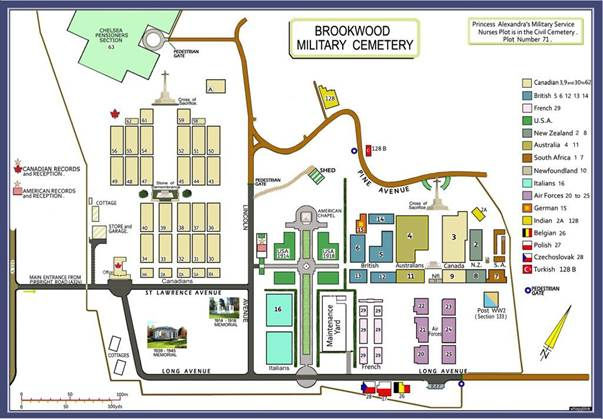
Figure 6. Map of the Brookwood
Military Cemetery in Surrey.
(Image courtesy of findagrave
internet web site)
Richardson’s burial was handled by The London Necropolis Company at 121 Westminster Bridge Road, London, S.E.1. According to the Commonwealth War Graves Commission he was buried in Section VIII, Row E, Grave 1A. A letter to his son George from The London Necropolis Company states that he was buried in grave 180066. The map above of the Brookwood Military Cemetery does not show a Section VIII for the British graves. It shows Sections 5, 6, 12, 13 and 14 for these graves.
On 5 June 1918 George Richardson’s son received a War Gratuity payment of £18-9s-3p sent to young George at 261 Springfield Road in Belfast. Although young George received this money, Richardson’s Statement of Names and Addresses of Relatives, Army Form W.5080 indicated that his half-Sister, Margaret Cooke, age 56 was his full blood next of kin. Some alteration in this form must have been made.
On 20 May 1933, young George Richardson (1901-1975) married Elizabeth Kirk (1910-2002) in Ballysillan Presbyterian Church in Belfast. According to available family trees, George and Elizabeth had a son and a daughter; George, born 14 April 1934 and Laura Hodgen Richardson, born 13 August 1935. George Richardson (1901-1975) died in Belfast on 8 March 1975, age 73. He was buried in Roselawn Cemetery in Belfast on 11 March 1975, grave T 983.
The following sections are presented in tabular form to summarize Richardson’s promotions, appointments, military training and qualifications and the medals that he was awarded during his time in the Army. They are provided to give the reader easy access to these aspects of his military service. The tables are followed by sections dealing with his marriage, personal information and post-service life.
Based on his exceptionally poor conduct while serving during the Great War, as expected, George Richardson did not receive any promotions during his time in service.
8. CONDUCT
Disciplinary Actions
George Richardson committed six serious offenses while serving during the Great War. These offenses included absent without leave (3 times), striking a superior officer, desertion and drunk on duty. These offenses resulted in forfeiture of 1 year and 130 days out of a total of 2 years and 344 days, so he effectively only served 1 year and 214 days.
Good Conduct Badges
Obviously he never received any Good Conduct Badges while in the Army. To say that his conduct was simply “Poor” is a kindness. The Army and the Corps of Royal Engineers would have been much better off if he had never been allowed to enlist.
9. MEDALS, AWARDS AND DECORATIONS
Despite his horrible conduct he did serve during the war and was entitled to the British War Medal and Victory Medal as shown on his Medal Index Card (MIC) and in Figure 7 below.
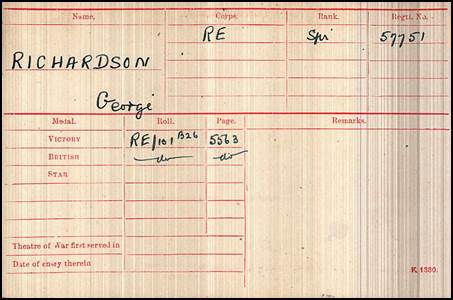
Figure 7. The Medal Index Card
of 57751 Sapper George Richardson, R.E.
(Image courtesy of
Wikipedia)
It should be noted that the card does not show the theatre of war in which he served or when he first entered a theatre of war. Since he did very little while he was in France, this omission, although probably an oversight, tells the true story of his poor performance. Oddly enough an entry on his Military History Sheet shows that he was entitled to the 1914-15 Star. This was obviously another error since he did not arrive in France until 4 January 1916. His family would have been entitled to receive a Memorial Plaque like the one shown in Figure 9 below, with Richardson’s name cast on it.
Figure 8. The British War
Medal and Victory Medal |
Figure 9. The Memorial
Plaque. |
10. EDUCATION AND QUALIFICATIONS
Education
There is no record of George Richardson’s education either prior to his enlistment or while serving in the Army.
Qualifications
Other than his civil and military qualifications, it must be assumed that he could ride horseback, as he had been posted to the mounted section of his company.
11. MEDICAL INFORMATION
Location |
Date of Admission |
Ailment or Medical Procedure |
Period of Hospitalization Or Treatment |
30th General Hospital, Calais |
2 Sep 1917 |
Pneumonia |
2 September to 8 October 1917 |
Queen Alexandra Military Hospital |
16 Oct 1917 |
Pneumonia/ tuberculosis |
16 October to 17 November 1917 |
|
|
|
Died in hospital |
12. FAMILY INFORMATION
As mentioned in Section 2, George Richardson had a number of half-siblings. These included:
Margaret Dalzell (1861-1931), born in Belfast on 6 June 1861. Margaret married one Robert Cooke in 1839 and had 9 children. She died in Belfast on 13 December 1931.
Anna Dalzell (1862-1880), born in Belfast on 16 October 1862. Anna apparently never married. She died in 1880 at the age of 18.
William Dalzell (1865-1917), born in Newtownards, Ireland.[6] William married one Isabella McDowell (1867-1949). They had 11 children. William died in Belfast on 28 April 1917.
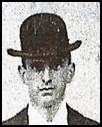
Figure 10. William
Dalzell.
(Image courtesy of Robert Spears)
Agnes Stevenson Dalzell (1867-1942), born in Belfast on 27 April 1867. Agnes married one John Robert Wallace (1863-1904) in the Parish of Shankill, Belfast on 16 February 1891. They had 13 children. Agnes married a second time to one James Arthur Wilson (?-1938). Agnes died in the Thornbury Convalescent Home in Rose Bay, New South Wales, Australia.
Figure 11. John Robert
Wallace. |
Figure 12. Agnes Stevenson
Blake, neé Dalzell. |
In addition to his half-siblings, George had a brother by his mother, Agnes Stevenson Dalzell and his father William John Richardson:
Thomas Alexander Richardson (1886-1962), born in Belfast. Thomas married one Agnes Matilda Wilkinson (1883-1962) in 1907. They did not have any children. Thomas died in Belfast on 5 March 1962.
REFERENCES:
Census
1911 Census of Ireland.
Documents
1. Chronology of the Service of the 150th Field Company, Royal Engineers.
2. Chronology of the Service of the 122nd Field Company, Royal Engineers.
Family Trees
1. William John Richardson (father) [from Ancestry.com by robertspears1892].
2. Agnes Stevenson (mother) [from Ancestry.com by robertspears1892].
3. George Richardson [from Ancestry.com by robertspears1892].
4. George Richardson (son) [from Ancestry.com by robertspears1892].
Internet Web Sites
1. Commonwealth War Graves Commission.
2. Ireland’s Memorial Records, 1914-1918.
3. WW1 Pension Record Cards and Ledgers.
4. Find a Grave.
Military Documents
1. Medal Index Card.
2. Royal Engineers Medal Roll, British War Medal and Victory Medal.
3. Soldier’s Effects.
4. Soldier’s Service Papers.
Short Service Attestation.
Descriptive Report on Enlistment.
Statement of Services, Army Form B. 200.
Military History Sheet.
Statement of Names and Addresses of Relatives, Army Form W.5080.
Medical Report, Army Form A. 21A.
Despatch of Effects, Effects – Form 118A.
Letter from The London Necropolis Company to Mrs. M. Cooke, dated 14 March 1918.
Note from George Richardson to The London Necropolis Company, dated 19 March 1918.
Periodicals
1. The Sapper magazine, July 1966.
2. Battle Honours of the Royal Engineers. The Royal Engineers Journal, The Institution of Royal Engineers, Chatham, Kent, 1925-1932.
ENDNOTES:
[1] Family trees from Ancestry.com by robertspears1892.
[2] A search of the Commonwealth War Graves Commission web site did not produce a result for this man being killed during the Great War. In any case he would have been 52 years old in 1917 and probably too old to have served in the war.
[3] From Google Earth it looks like this address is now the location of a large prison.
4 1911 Census of Ireland.
[5] This address no longer exists in Belfast.
[6] A search of the Commonwealth War Graves Commission web site did not produce a result for this man being killed during the Great War. In any case he would have been 52 years old in 1917 and probably too old to have served in the war.